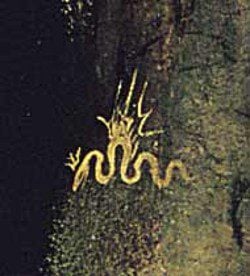Measuring negative time. Court rules that zoos are not prisons. And the secret to a long life.
The old scientific materialism, which reduces everything in the universe to simple matter obeying rational laws, is dissolving before our eyes. Quantum physics, the study of nature at or below the atomic level, is disclosing fundamental facts of the universe that go far beyond what our human minds can comprehend.
Here is another example of “weird science,” as described in EcoNews: Negative time, observed for the first time ever: Flowing from the future to the past. Basically, scientists from the University of Toronto found that packages of light (photons) sent through a material exited it before fully entering it.
Let’s let the science reporter explain it, though “explain” is hardly the word:
[The scientists Aephraim Steinberg and Daniela Angulo] measure the length of time atoms absorb then emit light, ”exciting” them temporarily. Amazingly, some of these times appeared to be shorter than zero. Steinberg explained that the results would not allow time travel or breaches of the physical laws as normally understood. . . .
These tests were held in a kind of basement laboratory full of lasers, mirrors, and wires, and were directed at careful measurement of photon’s behavior. When photons pass due to a material, they are absorbed and emitted and momentarily change the state of the atoms involved.
By analyzing the duration of interaction, Angulo’s team picked up intervals that were beyond what one would expect; it was as though the photons had exited the material before having entirely entered it.
Some scientists are trying to find other explanations of the phenomenon, but the researchers are standing by their observations.
Here is another article on “Negative Time,” with links to the published research.
As I say in my book Post-Christian: A Guide to Contemporary Thought and Culture, the modernists thought that science was banishing the mysteries of nature, thus undermining the possibility of supernatural religion. But now, science has progressed to the point that the more we know, the more mysterious nature becomes.
And Spencer Klavan, in Light of the World, Light of the Mind is arguing that the new science disproves naturalistic materialism and makes religion credible again.
Court Rules That Zoos Are Not the Same as Prisons
Animal rights activists have been launching legal battles in hopes they will classify animals as “persons” with inalienable rights.
The Nonhuman Rights Project filed a case on behalf of five elephants against the Cheyenne Mountain Zoo in Colorado Springs, invoking habeas corpus, protections against unlawful imprisonment or detention.
The quite progressive Colorado Supreme Court, however, ruled in a unanimous decision that animals are not “persons,” so habeas corpus does not apply.
The anti-zoo group wanted the elephants released to an animal sanctuary. But, as Wesley J. Smith points out, the Nonhuman Rights people were not planning to give the animals their “freedom” by releasing them into the wild or into Colorado Springs neighborhoods. Putting them in an animal sanctuary would still “detain” them. If an animal sanctuary is humane, why can’t a zoo also be or be made to be humane?
If we empty the zoos and return the animals, including endangered species, to their native habitats, they would be threatened by poachers, who have caused the species to be endangered. Also, animals born and raised in zoos, where they have been fed and cared for, often cannot adapt to conditions in the wild, where they have to forage, hunt, and defend themselves on their own.
My point is, you can be an animal lover, without buying into the Animal Rights movement and while still appreciating zoos, which can be called out if they mistreat animals.
The Secret to a Long Life
Investment in longevity research is expected to reach $600 billion this year, fueled in part by tech moguls who hope to cheat death and live in this world forever.
One line of research has found special “blue zones” where people routinely live for more than a hundred years. Scientists and self-help entrepreneurs are studying Okinawa, Japan; Sardinia, Italy; Nicoya, Costa Rica; Ikaria, Greece; and Loma Linda, California to learn why, hoping to replicate their longevity in the rest of the world.
But Saul Justin Newman, a researcher at University College London’s Centre for Longitudinal Studies, found that most cases of extreme old age–the so-called “supercentenarians”–are found in areas of high poverty, poor health, and bad record-keeping. How can that be? He found out.
Sogen Kato was thought to be Japan’s oldest man at 111 years old. When Japanese officials sought to honor him, his relatives refused to let them see him. In 2010, his mummified body was discovered in his bedroom. It turns out he had died in 1978 at the age of 79. His relatives kept that a secret so that they could keep cashing his pension checks.
Such scams, it turns out, are not uncommon. Japan launched an investigation and found that 82% of their citizens over the age of 100 were actually dead or missing. Newman found that 42% of the centenarians in Costa Rica had lied about their age. In Greece, 72% of the centenarians are dead or imaginary.
Of course, there are people who live to the age of 100 and beyond. But, says Newman, most old-age data “is junk to a really shocking degree.”
He concludes that the secret to a really long life is to “move where birth certificates are rare, teach your kids pension fraud, and start lying.”

















